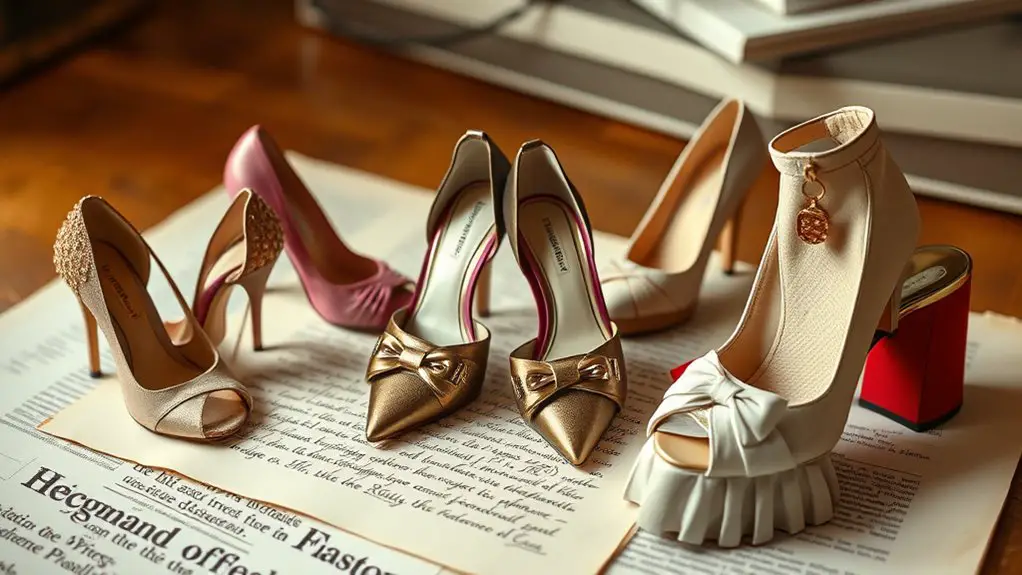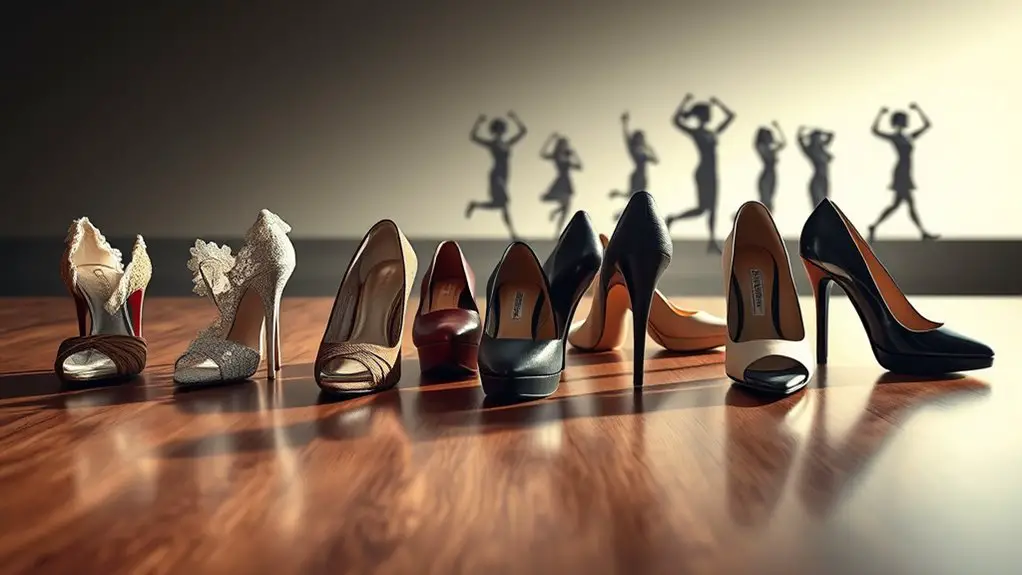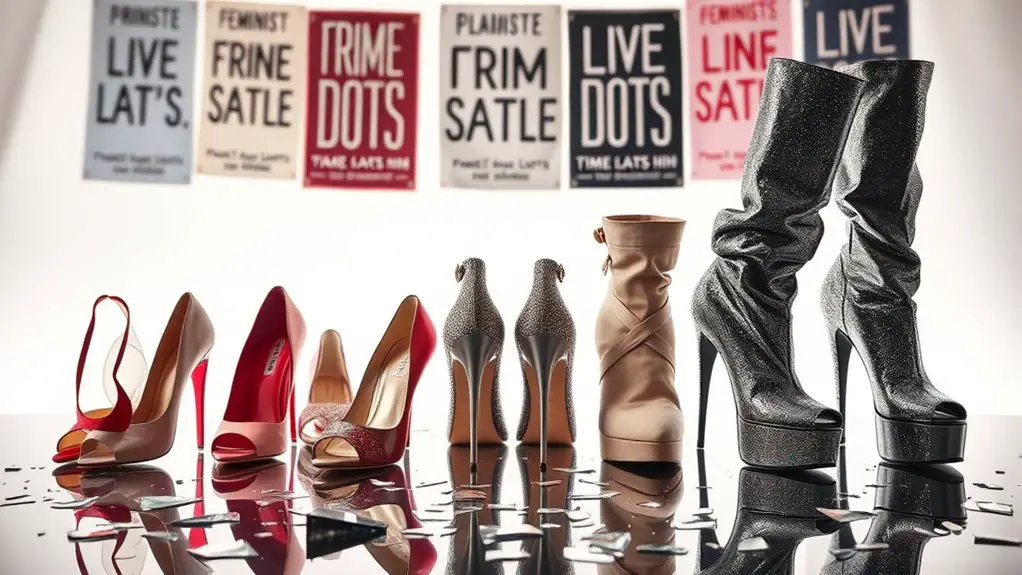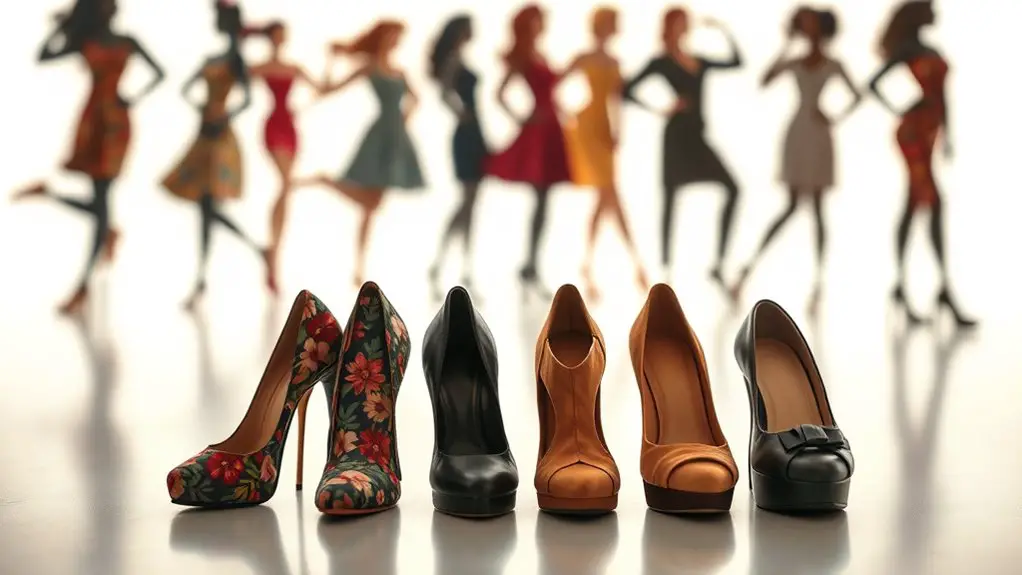The evolution of heels in the feminist movement illustrates a complex journey from status symbols to expressions of autonomy. Initially, heels signified wealth and societal expectations, but during the Women’s Liberation Movement, they transformed into tools of empowerment. Women began to reclaim heels, using them to assert confidence and challenge norms. Yet, they remain a paradox, embodying both empowerment and oppression. This duality continues to shape contemporary discussions about femininity, identity, and body positivity, revealing deeper layers worth exploring.
The Historical Origins of Heels

Although heels are often associated with femininity and fashion, their origins are surprisingly complex and intertwined with various cultural and social movements. You might be surprised to learn that heels date back to the 10th century, initially worn by Persian cavalry to help secure their feet in stirrups. This historical context reveals that heels weren’t always a symbol of female allure; rather, they were practical footwear that evolved over centuries. By the 16th century, European aristocrats adopted heels, marking a shift in cultural significance as they became a symbol of status and power.
As you explore this journey, you’ll see how heels transformed from a utility item to an emblem of gender norms, influencing women’s roles in society. Understanding these historical origins allows you to appreciate the multifaceted relationship between heels and the feminist movement, as they embody both empowerment and constraint within the fabric of women’s history.
Heels as a Symbol of Status and Class
When you slip on a pair of heels, you’re not just choosing a style; you’re stepping into a complex web of social hierarchy and economic power. These shoes have long been a marker of status, often signaling wealth and access to exclusive spaces. As you navigate this world, consider how heels can both empower and constrain, reflecting the intricate dynamics of class in society.
Fashion and Social Hierarchy
As you navigate the world of fashion, it’s hard to ignore how high heels have evolved into a potent symbol of status and class. Once merely aesthetic choices, they now reflect deep-rooted social mobility and cultural perceptions. High heels often reinforce gender roles, aligning femininity with elegance and desirability, while also accentuating class distinctions. Fashion trends frequently dictate the popularity of specific styles, influencing societal expectations around appearance. The economic implications of wearing designer heels further highlight these disparities, as they often signal wealth and privilege. Ultimately, heels embody a complex interplay of fashion and social hierarchy, shaping how individuals are perceived and treated within various social contexts. These dynamics reveal much about our values and aspirations in contemporary society.
Economic Power Dynamics
High heels have become more than just a fashion statement; they represent a complex web of economic power dynamics and social stratification. When you step into a pair, you’re not just enhancing your height but also maneuvering workplace attire shaped by gender stereotypes. Heels symbolize economic independence, marking a shift in corporate culture where power dressing is essential for climbing the corporate ladder. Your consumer choices reflect broader fashion economics, as brands often target those aiming for status through style. Yet, amid this allure, salary disparities remind us that the heels you wear can’t mask systemic inequalities. Ultimately, while they signify aspiration, they also underscore the paradox of empowerment and constraint within the feminist movement.
The Shift in Perception During the Women’s Liberation Movement

As you explore the Women’s Liberation Movement, you’ll notice how heels transformed from mere fashion accessories to potent symbols of empowerment. This era reframed the narrative around women’s choices, challenging the idea that high heels were solely tools of objectification. Instead, they began to be seen as a statement of autonomy, allowing women to reclaim their bodies and express their identities.
Empowerment vs. Objectification
While the Women’s Liberation Movement challenged traditional gender roles, the debate surrounding high heels exemplified the broader conversation about empowerment versus objectification. As you navigate this complex landscape, you might notice how empowerment narratives emerged, portraying high heels as symbols of confidence and autonomy. Yet, this perspective often clashed with objectification perceptions, suggesting that heels could reduce a woman’s worth to mere appearance. The friction between these viewpoints reflected a significant turning point in feminist discourse. You may find that some women embraced heels to assert their identity, while others rejected them as tools of oppression. This duality encapsulated the struggle many faced in redefining femininity, prompting a deeper examination of how fashion choices intersect with personal agency and societal expectations.
Fashion Statement Reimagined
The Women’s Liberation Movement marked a significant turning point in how fashion was perceived, transforming garments like high heels into powerful symbols of self-expression. As you explore this fashion evolution, it becomes clear that heels evolved from mere accessories to statements of autonomy. During the movement, women began to reclaim their narratives, using heels to assert confidence rather than conform to traditional femininity. This shift highlighted their cultural significance, as heels became emblems of strength and defiance against societal expectations. Instead of being shackled by objectification, you’d find women embracing heels as tools of empowerment. This reimagining of fashion not only challenged stereotypes but also reshaped the conversation around women’s rights, proving that style can be both political and personal.
High Heels and the Rise of Feminine Identity
High heels have long been more than just a fashion statement; they represent the complex interplay between femininity and empowerment. When you slip on a pair of high heels, you’re not just elevating your stature—you’re engaging with a rich cultural narrative that celebrates feminine identity. This footwear has evolved to symbolize feminine empowerment, allowing women to assert their presence in various spaces traditionally dominated by men.
In many contexts, high heels convey confidence and assertiveness, transforming the way you perceive yourself and how others perceive you. The cultural significance of heels lies in their ability to challenge and redefine norms; they can evoke both allure and strength. As you navigate through different social settings, high heels can serve as a powerful tool of expression, intertwining your personal identity with broader movements advocating for women’s rights and equality. Consequently, heels become a canvas for your evolving feminine identity, rich with meaning and intent.
The Debate: Empowerment vs. Oppression

As you navigate the complexities of the feminist movement, the debate surrounding high heels often hinges on a paradox: are they symbols of empowerment or instruments of oppression? On one hand, some empowerment narratives celebrate heels as expressions of individuality and confidence, allowing women to challenge societal expectations and assert their presence. In this light, you might see them as tools for self-expression, enhancing your stature—both literally and metaphorically.
Conversely, critics argue that high heels perpetuate a restrictive beauty standard, reinforcing traditional gender roles that dictate how women should present themselves. You may feel the weight of societal expectations, which can stifle your autonomy and lead to discomfort. This duality reflects broader struggles within the feminist movement, as you consider how personal choices intersect with collective identity. Ultimately, the debate invites you to question what empowerment truly means and how it aligns with your experience in a world shaped by complex societal norms.
Heels in Contemporary Feminist Discourse
While many modern feminists grapple with the implications of wearing heels, their presence in contemporary discourse reflects a nuanced understanding of choice and autonomy. Within the framework of intersectional feminism, some women embrace heels as a form of self-expression, challenging traditional gender norms and beauty ideals. This choice often intersects with body positivity, allowing individuals to reclaim their personal agency.
However, the feminist critique doesn’t shy away from acknowledging the historical context and potential for cultural appropriation in workplace fashion. For some, heels symbolize empowerment, while others view them as a perpetuation of oppressive standards. This ongoing dialogue highlights the complexity of heels in contemporary feminist discourse, where wearing them can signify both liberation and conformity. Ultimately, it’s about how you navigate these choices, balancing societal expectations with your identity and values, fostering a space where personal expression meets collective consciousness.
The Influence of Popular Culture on Heel Acceptance
Popular culture plays a significant role in shaping societal perceptions of heels, influencing how they are embraced or rejected within feminist discourse. From iconic films to social media influencers, pop culture often dictates what’s fashionable and acceptable. When you see powerful women in heels on screen, it sends a message that wearing them can symbolize confidence and ambition. Conversely, viral movements that challenge traditional beauty norms can lead to heel rejection, advocating for comfort and practicality instead.
As you engage with these narratives, you might notice that your own views on heel acceptance are shaped by the cultural messages you consume. Whether it’s a celebrity strutting down a red carpet or a meme mocking high heels, these cultural references affect how you perceive the role of heels in empowerment or oppression. Accordingly, pop culture continues to mold the conversation around heels, making it a vital element of the feminist movement’s evolution.
Personal Narratives: Women’S Experiences With Heels
Many women have complex relationships with heels, shaped by personal experiences that intertwine comfort, confidence, and societal expectations. You might find that your heel preferences vary based on the occasion or your mood, leading to a unique journey. Here are some common themes in women’s narratives:
- Empowerment: Many women feel a surge of confidence when donning a pair of heels, transforming their posture and mindset.
- Discomfort: Conversely, the toll on your feet can be significant, leading to a love-hate relationship with a fashion staple that often sacrifices comfort for style.
- Societal Pressure: External expectations can dictate your choices, making you question if wearing heels is about personal preference or conforming to norms.
These personal experiences shape how you view heels, often revealing deeper insights into self-expression and societal roles. Understanding these narratives can help redefine your relationship with this iconic footwear.
Redefining Beauty Standards in the Age of Choice
As the fashion landscape evolves, you’re likely noticing a shift in how beauty standards are defined, particularly regarding women’s footwear choices. Heels have long been a symbol of femininity, yet today, you’re seeing a more nuanced perspective emerge. The body positivity movement encourages you to embrace your individuality, promoting the idea that beauty isn’t confined to a specific look or style.
In this age of choice, wearing heels is often a personal decision rather than an imposed expectation. You’re empowered to choose styles that resonate with your identity, whether that’s opting for comfortable flats, vibrant sneakers, or classic heels. This shift reflects a broader societal change towards valuing comfort and authenticity over traditional standards.
As you navigate your footwear choices, remember that your expression of beauty is valid, and your preferences matter in redefining what it means to be beautiful today.
Frequently Asked Questions
Are There Specific Cultures That Have Historically Embraced High Heels?
Many cultures, from ancient Egyptians to modern Western societies, have embraced high heels, each infusing them with cultural significance. Historically, these shoes symbolize status, femininity, and power, reflecting societal values and evolving norms through time.
How Do Heels Impact Women’s Health and Well-Being?
Heels can greatly impact your health; they often lead to foot pain and altered body posture. While they might enhance your appearance, it’s essential to take into account the long-term effects on your overall well-being.
What Are the Most Common Materials Used in High Heel Production?
When you step into high heels, you’re often embracing a blend of synthetic materials and natural leather. These choices reflect both style and durability, shaping your experience while traversing the world in chic footwear.
Are There Alternative Footwear Options That Offer Similar Aesthetics Without Heels?
If you’re seeking alternatives to heels, consider sustainable sneakers and stylish flats. These options provide a chic aesthetic while prioritizing comfort and eco-friendliness, allowing you to express your style without sacrificing your well-being.
How Do Fashion Trends Influence Heel Designs Over Time?
Fashion cycles act like a pendulum, swinging between classic and contemporary. As trends evolve, design innovations reshape heels, blending aesthetics with functionality. You’ll notice how societal shifts inspire styles, reflecting cultural values and aspirations over time.



